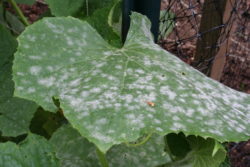Japanese Beetles are here!
Japanese beetle can be very damaging to plants. Adults feed on leaves, buds and flowers of many common garden and landscape plants. On leaves feeding is usually restricted to the softer tissues between the larger leaf veins, which results in a characteristic feeding pattern known and described as ‘skeletonizing’. More generalized ragged feeding occurs on softer tissues, notably flower petals; rose flowers are particularly susceptible to Japanese beetle injury. Damage on individual plants may be patchy, concentrated where aggregations of feeding beetles occur.
Hand picking beetles can be effective in small plantings. The beetles are easily picked or dislodged into a container of soapy water especially in early morning. The regular removal of beetles prevents the feeding damage by those beetles and also deters other beetles from aggregating on the plant. Beetle presence on plants and prior injury is attractive to other beetles.
Adult Japanese beetles can be effectively controlled by use of sprayed insecticides which either kill and/or repel beetles and are particularly effective and may provide protection of plants for 2-3 weeks following a single application. As with all pesticide applications, read the label and follow the directions carefully. Make your application in the evening, after the sun has gone down so as not to disturb the honeybees. Best options below:
- Bonide Captain Jacks’ Deadbug RTU – Spinosad, naturally occurring bacteria – softest
- Bonide Eight RTU & RTS – synthetic pyrethrin – softer
- Fertilome Triple Action RTS – Neem oil, pyrethrins – big guns!
Budworms are showing up again!
 Now is the time to treat for Budworm again. These little light green worms have two cycles per summer – early July and early August. Budworms prefer to feed on petunia, geranium and verbena plants. They feed on the flower buds of these species. You might notice that there are less and less flowers, flowers that looked chewed upon, or little black worm droppings in the leaves. Treat with the biological BT (Bacillus thurengiensis) or spray with Bonide Eight or Captain Jack’s Deadbug or Hot Pepper Wax. Treat now to help keep these flowers in full bloom all summer long.
Now is the time to treat for Budworm again. These little light green worms have two cycles per summer – early July and early August. Budworms prefer to feed on petunia, geranium and verbena plants. They feed on the flower buds of these species. You might notice that there are less and less flowers, flowers that looked chewed upon, or little black worm droppings in the leaves. Treat with the biological BT (Bacillus thurengiensis) or spray with Bonide Eight or Captain Jack’s Deadbug or Hot Pepper Wax. Treat now to help keep these flowers in full bloom all summer long.
Treat now and treat again in late July to help keep these flowers in full bloom all summer long. Consider using:
- Natural Guard RTU Caterpiller killer w/ Bt, the biological Bacillus thurengiensis
- Fertilome Dipel Dust w/ Bt
- Bonide RTU Captain Jack’s Deadbug w/ biological Spinosad
- Bonide Eight RTU for small applications or the hose end RTS for large applications
*Please read and follow all directions provided by manufacturer of each product your try*
Powdery Mildew
 Powdery mildews are one of the most widespread and easily recognized plant diseases. Powdery mildews are characterized by spots or patches of white to grayish, talcum-powder like growth. Several cultural control practices will reduce or prevent powdery mildews.
Powdery mildews are one of the most widespread and easily recognized plant diseases. Powdery mildews are characterized by spots or patches of white to grayish, talcum-powder like growth. Several cultural control practices will reduce or prevent powdery mildews.
Avoid overhead watering to help reduce the relative humidity and water early in the day. Selectively prune overcrowded plant material to help increase air circulation. This helps reduce relative humidity and infection.
If cultural controls fail to prevent disease buildup or if the disease pressure is too great, an application of a fungicide may be necessary. Most chemical controls are applied as a preventative measure. The chemical spray provides a protective coating on the plant which can prevent spore germination. These include: Bonide Copper Fungicide, Fertilome Broad Spectrum Fungicide or Fertilome F-Stop. The Green Team will help you select the best control for your application.
